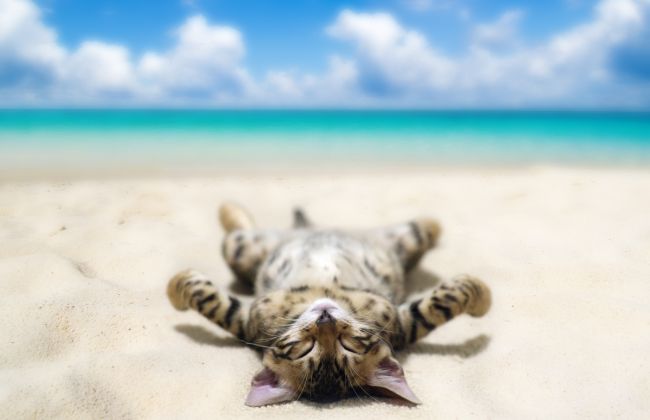
Most of us have gotten our fair share of sunburns, and have freckles to prove it! As Americans spend millions of dollars annually to protect the skin from the sun’s damaging UV rays, the same consideration is often not given to their pets. Because of the thick layer of fur that domestic animals possess, it seems almost laughable to imagine slathering sunblock on over their fuzzy coats. However, pet dermatologists and veterinarians are witnessing a rise in pet sunscreen purchasing, as awareness about sun damage in pets is increasing –and for good reason! Note the dangers of allowing your pet to play outside without protection from the sun.
Dangers of Sun Damage for Pets
Like humans, heavy exposure to the sun’s ultraviolet rays can cause burning, blistering, heat rashes, skin peeling, infection, disease and even melanoma. Even though dogs and cats wear a thick layer of fur, there may be subtle vulnerable areas that could suffer harm. Hard to believe? Image this scenario: your dog has a hot spot on his left hip. He falls asleep on the back porch and gets a severe burn on the hairless patch. The burn blisters, itches and then ruptures when he scratches it, becoming an exposed wound. Your pup then goes romping in a public park the next evening on your walk, and rolls around on the grass where there are fecal remnants of a dog that was infected with worms. The worms enter your dog’s body through the open wound, and now he carries whipworms, roundworms, or another detrimental parasite. A little sun-protection could have avoided all that trouble!
When Does Your Pet Need Sunscreen?
- If he/she is a hairless breed: Both hairless cat and dog breeds are subject to severe sun damage if their skin is exposed. Dog breeds like the Chinese Crested, Thailand temple dogs, American Hairless Terriers, Peruvian Inca Orchids, and Xploitzcuintlis need to be covered in sunblock. Hairless cats like the Sphynx, Ukrainian Levkoy, Bambino, and the Elf cat also require protection.
- If he/she has hair loss: Hair loss might occur evenly throughout the animal’s body, due to allergies, stress, seasonal changes, or even fluctuating hormones. Hair might also be missing in specific areas where there are hot spots, bald patches, or even wounds or places that received trauma. Some pets have thinning hair as they age, leaving the scalp open to burning from the sun.
- If he/she sleeps in the sun often: Cats typically sleep between 12-17 hours a day (hence the term “sat nap”), and dogs love lounging on lawns, decks, and by windows. Prolonged light exposure can be the most deadly, as cats and dogs snooze in a comfortable warm bliss for hours on end. If your pet has an affinity for resting in the sunshine, you will have to start applying sunscreen regularly.
- If he/she spends hours daily outdoors: The same principle applies to over active pets as it does to lazy nap-takers. Some animals like to explore the furthest reaches of their yard or garden, and will find endless entertainment and games for themselves for hours without coming in for a break. Not only can this put the cat or dog’s skin in jeopardy, but extended play in the sun also causes them to run the risk of dehydration.
- If he/she is recently groomed: Soaring summertime temperatures tempt pet owners to help their pet’s cool off with a close shave. Trimming down the long winter coats may certainly save your pet some agony in the hot weather, but if the cut is close to the skin, the scalp could be susceptible to burning. While the hair is growing back, be sure to keep that sunblock handy!

